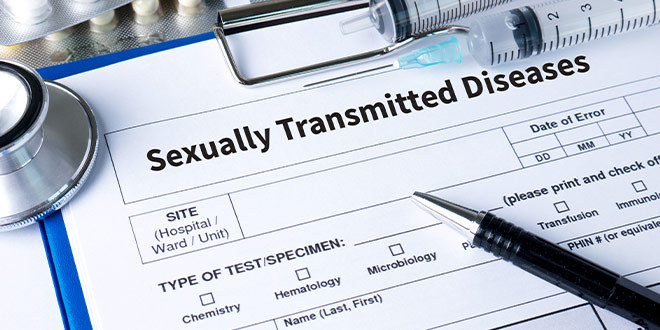“A clean bill of sexual health” is a phrase used to mean that you are STD free. But (we have to address the problems) let’s talk about the trouble with this phrase. An STD is more accurately referred to as an STI (sexually transmitted infection), because not all infections lead to symptoms and diseases, especially in the short term. And what if you have an STI? Is your “bill of health” then dirty? And what would that make you, the bearer of said bill and STI? Presumably dirty by association, as is, it is implied, the activity that created the possibility for infection – sexual engagement (activity).

However, STIs are not “dirty”. And while they are related to sexual engagement, they do not happen because of personal hygiene practices or because sexual engagement (activity) is amoral or obscene. STIs are simply infections, caused by viruses, bacteria, and other infectious organisms. They are no more “dirty” than common respiratory illnesses such as a cold or even COVID. But, just like these, they are common and many of these may have serious repercussions.
So how do you ensure you remain infection free? Again, like COVID, start by knowing your physical health and risk factors. Visit your physician, whether that is a general practitioner, a gynecologist, a urologist, or another for a physical. Then, when you decide to engage in sexual activity, protect yourself. The best methods for safer sex are barrier methods. These are different from birth control, which is only for preventing pregnancy. Barrier methods, which also work to decrease the risk of pregnancy, are the only methods that decrease rates of STIs as well. They work by forming a barrier through which the infecting organism cannot pass. Think of them like COVID masks but all your sexually involved body parts. Barrier methods are not just the (male) condom, but are also the female (or insertive) condom as well as dental dams (a piece designed for cunnilingus or anal/oral play) and medical grade gloves. And right now, in 2021, it might also include that face mask. When used consistently and correctly, these greatly reduce the risk of giving or getting an infective agent. To be clear, consistently and correctly means using them as per instructions, any time any of the sexual body parts come together, so also during oral stimulation and even during manual stimulation, especially if the skin on your hands is compromised.
But greatly reduced risk is still NOT no risk. So, one must consider any sexual contact a potential to become exposed or infected (again, not dirtied, simply having had an opportunity to come in contact with an infectious organism, just like being out and about these days increases your COVID risk). And if you want to be truly safe and healthy, but still enjoy sexual contact, what do you do? Same thing you do if you want to make sure you don’t have COVID – you get tested! This leads to the question of for what, and when (how frequently)?
There are a number of STIs to be aware of and potentially test for (See Table 1). And while the symptoms (See Table 2) and consequences (See Table 3) of these STIs are varied, they include some serious and life-threatening outcomes, up to and including social stigma, emotional and mental distress, and potential for death. It is important to know about these, but they are not listed as scare tactics. Understanding these consequences is simply additional information to help you make and balance your personal pleasure supporting, yet risk reducing plan.
| Table 1: STIs |
*(associated with increased risk of becoming infected or transmitting other STIs, may be transmitted amongst women who have sex with women) |
| Table 2: Most Common STI Symptoms |
|
| Table 3: Most Notable STI Consequences |
|
So, where and when does testing fit into this? Different health groups have different recommendations, but for sexually active adults they generally recommend a bare minimum of 1x/ year testing for gonorrhea, chlamydia, and possibly HIV and syphilis. And if you engage with multiple partners, or have sex without barrier protection, testing is recommended every 3-6 months. But from a sexual health perspective, think of this as similar to how you ensure safety during COVID. If you are engaging with a new partner, it is beneficial to know the health status and habits of all parties prior to engagement, then check in throughout the relationship as long as others are involved. This requires both initial and ongoing testing and talking about the results.
Additionally, testing sooner or again should be considered if you do enter start interacting without knowing the STI status of all parties involved, if you have a failure of barrier protection without knowing your partner’s status, if you experience any symptoms, or if you become pregnant. But there is a caveat to all of this: the timing of testing may also require you be tested more than once.
This is because of the incubation period – the time for an infecting organism to take hold, multiply, and induce the body to create an antibody response. The incubation period for COVID is why you do not get accurate test results if you take a test less than 3 days after exposure. Different STIs also have different incubation periods, remarkably ranging from 1 day up to 20 years. And some STI tests measure the antibodies, not the organism. So discuss with a health care provider whether you need to get tested more than once or consider continuing to test yearly, for a while, even if you are monogamous or have stopped sexual engagement with others, to ensure you are infection free.
Testing is done by most physicians and available at many, many public health clinics. It will usually be covered by insurance and/or is offered for free at some clinics. Even if there is a small charge, though, remember, the cost of the test is always cheaper than the possibility of serious health repercussions. So, bottom line, please, please make sure you protect yourself and know your status. Because being STI free, just like being COVID free, while not appropriately described as “clean”, is certainly a fun and freeing starting point for better sexual, physical, and mental health.
